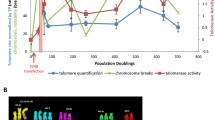Abstract
We have reported the establishment of new episomal-type expression vector the copy number of which can be readily regulated by a temperature shift. In this study, we attempt to apply this vector for the functional analysis of the noncoding regions of DNA. A plasmid containing a 0.45 kb-telomere repeat sequence was constructed and transfected into simian CV-1 cells, leading to successful establishment of cell lines in which episomal telomere sequence could be amplified by temperature shift. When the episomal telomere sequence was amplified, the cells stopped proliferating at the G2/M phase of the cell cycle and exhibited a large size with flattened morphology and several small nucleus-like particles. These cells expressed Cdk inhibitor p21 and β-galactosidase, which are expressed in some senescent cells. Microscopic analysis revealed frequent end-to-end attachments of chromosomes, which resulted in a variety of aberrant chromosome configurations. None of these characteristics was observed in nontransfected and control plasmid-transfected CV-1 cells at any cultivation temperature. These results indicate the usefulness of our vector system in analyzing telomeric DNA.
Similar content being viewed by others
References
Bode J, Kohwi Y, Dickinson L, Joh T, Klehr D, Mielke C and Kohwi-Shigematsu T (1992) Biological significance of unwinding capability of nuclear matrix-associating DNAs. Science 255: 195–197.
Bodnar AG, Ouellette M, Frolkis M, Holt SE, Chiu C-P, Morin GB, Harley CB, Shay JW, Lichtsteiner S and Wright WE (1998) Extension of life span by introduction of telomerase into normal human cells. Science 279: 349–352.
Cenci G, Rawson RB, Belloni G, Castrillon DH, Tudor M, Petrucci R, Goldberg ML, Wasserman SA and Gatti M (1997) UbcD1, a Drosophila ubiquitin-conjugating enzyme required for proper telomere behavior. Genes & Dev 11: 863–875.
Dimri GP, Lee X, Basile G, Acosta M, Scott G, Roskelley C, Medrano EE, Linskens M, Rubeji I, Pereira-Smith O, Peacocke M and Campisi J (1995) A biomarker that identifies senescent human cells in culture and in aging skin in vivo. Proc Natl Acad Sci USA 92: 9363–9367.
El-Deiry WS, Tokino T, Velculescu VE, Levy DB, Parsons R, Trent JM, Lin D, Mercer WE, Kinzler KW and Vogelstein B (1993) WAF1, a potential mediator of p53 tumor suppression. Cell 75: 817–825.
Feng J, Funk WD, Wang SS, Weinrich SL, Avilion AA, Chiu CP, Adams RR, Chang E, Allsopp RC, Yu J, Le S, West MD, Harley CB, Andrews WH, Greider CW and Villeponeau B (1995) The RNA component of human telomerase. Science 269: 1236–1240.
Harley CB, Futcher AB and Greider CW (1990) Telomeres shorten during aging of human fibroblast. Nature 345: 458–460.
Hayflick L (1965) The limited in vitro lifetime of human diploid cell strains. Exp Cell Res 37: 614–636.
Ikeno M, Grimes B, Okazaki T, Nakano M, Saitoh K, Hoshino H, McGill NI, Cooke H and Masumoto H (1998) Construction of YAC-based mammalian artificial chromosomes. Nature Biotechnol 16: 431–439.
Kirinaka H, Kamihira M, Iijima S and Kobayashi T (1994a) A new runaway-type episomal vector for mammalian cells based on a temperature-sensitive simian virus 40 and inducible erythropoietin production. Appl Microbiol Biotechnol 41: 591–596.
Kirinaka H, Kamihira M, Kobayashi T and Iijima S (1994b) Inducible production of erythropoietin using new runaway-type vector by mammalian cell culture in spinner flask. J Ferment Bioeng 78: 483–485.
Kirinaka H, Kamihira M and Iijima S (1995) Host range specificity of a novel runaway-type vector for mammalian cells. J Ferment Bioeng 79: 360–362.
Kirk KE, Harmon BP, Reichardt IK, Sedat JW and Blackburn EH (1997) Block in anaphase chromosome separation caused by a telomerase template mutation. Science 275: 1748–1481.
Meyerson M, Counter CM, Eaton EN, Ellisen LW, Steiner P, Caddle SD, Ziaugra L, Beijersbergen RL, Davidoff MJ, Lie Q, Bacchetti S, Haber DA and Weinberg RA (1997) hEST2, the putative human telomerase catalytic subunit gene, is up-regulated in tumor cells and during immortalization. Cell 90: 785–795.
Nakayama J, Saito M, Nakamura H, Matsuura A and Ishikawa F (1997) TLP1: a gene encoding a protein component of mammalian telomerase is a novel member of WD repeats family. Cell 88: 875–884.
Noda A, Ning Y, Venable SF, Pereira-Smith OM and Smith JR (1994) Cloning of senescent cell-derived inhibitors of DNA synthesis using an expression screen. Exp Cell Res 211: 90–98.
Parker SB, Eichele G, Zhang P, Rawls A, Sands AT, Bradley A, Olson EN, Harper JW and Elledge SJ (1995) p53-independent expression of p21cip1 in muscle and other terminally differentiating cells. Science 267: 1024–1027.
Stief A, Winter DM, Strätling WH and Sippel AE (1989) A nuclear DNA attachment element mediates elevated and position-independent gene activity. Nature 341: 343–345.
Van Steensel B and de Lange T (1997) Control of telomere length by the human telomeric protein TRF1. Nature 385: 740–743.
Van Steensel B, Smogorzewska A and de Lange T (1998) TRF2 protects human telomeres from end-to-end fusions. Cell 92: 401–413.
Rights and permissions
About this article
Cite this article
Mizuarai, S., Nishijima, Ki. & Iijima, S. Amplification of competitive telomere sequence in living animal cells induces chromatin instability. Cytotechnology 31, 195–203 (1999). https://doi.org/10.1023/A:1008088609398
Issue Date:
DOI: https://doi.org/10.1023/A:1008088609398




